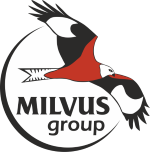Between 10 to 31 January the Romanian Ornithological Society (SOR) and the Milvus Group Bird and Nature Protection Association organised the national winter waterbird synchronous count (commonly known as Midwinter) in Romania, coordinated internationally by Wetlands International.
A total of 197 observers participated in the survey, covering 537 wetlands or sites nationwide. The total number of birds observed was 1,046,241, of which about 891,013 (85%) belonged to different waterbird species. A total of 179 bird species were identified, of which 92 (51.4%) could be classified as waterfowl or as species whose life cycle is closely linked to wetlands
The number of waterbird species recorded this year exceeded the previous year by more than 330,000 individuals (a significant increase compared to 2023), thanks to better coverage of wetlands.
This year’s count relied entirely on volunteers, who collected data alongside staff from both organisations. We greatly appreciate the continued volunteer participation of our observers, who are responsible for collecting this valuable information to help us monitor waterfowl populations on a national scale.
The most frequently observed waterbird species were (this excludes goose species, whose populations were covered much more fully by a dedicated survey), with the numbers recorded in the previous year in brackets for comparison:
- Mallard (Anas platyrhynchos) – 237323 ind. (172742 ind.)
- Eurasian Coot (Fulica atra) – 141450 ind. (92271 ind.)
- Great Cormorant (Phalacrocorax carbo) – 42.067 ind. (29.637 ind.)
- Black-headed Gull (Chroicocephalus ridibundus) – 29.005 ind. (34.967 ind.)
- Pochard (Aythya ferina) – 25.623 ind. (23.361 ind.)
- Mute Swan (Cygnus olor) – 22.877 ind. (20.857 ind.)
- Red-crested Pochard (Netta rufina) – 22.074 ind. (585 ind.)
- Tufted Duck (Aythya fuligula) – 20.420 ind. (17.693 ind.)
- Teal (Anas crecca) – 19.621 ind. (27.587ind.)
- Caspian Gull (Larus cachinnans) – 17.118 ind. (26.434 ind.)
Of the non-aquatic species, the largest numbers belonged to the following species:
- Wood Pigeon (Columba palumbus) – 64.433 ind.
- Rook (Corvus frugilegus) – 30.583 ind.
- Feral Pigeon (Columba livia f. domestica) – 10.262 ind.
- Western Jackdaw (Corvus monedula) – 7.680 ind.
- Fieldfare (Turdus pilaris) – 6.303 ind.
- Common Magpie (Pica pica) – 3.231 ind.
- Hooded Crow (Corvus cornix) – 3.167 ind.
- Goldfinch (Carduelis carduelis) – 3.109 ind.
- Tree Sparrow (Passer montanus) – 2.722 ind.
- Chaffinch (Fringilla coelebs) – 2.337 ind.
During the observations, some surveyors have managed to record species that are rare in our country, occur sporadically or are of interest during the winter. For example, the Slavonian Grebe (Podiceps auritus) – 13 ind., the White Pelican (Pelecanus onocrotalus) – 19 ind., the Canada Goose(Branta canadensis) – 1 ind., the Bean Goose(Anser fabalis) – 2 ind. (4 individuals were recorded during the national goose survey), the Velvet Scoter (Melanitta fusca) – 41 ind., Common Scoter (Melanitta nigra) – 3 ind., Long-tailed Duck (Clangula hyemalis) – 13 pd., Glaucous Gull (Larus hyperboreus) – 1 ind., Ring-billed Gull(Larus delawarensis) – 1 ind., Pallas’s Gull(Larus ichthyaetus) – 60 ind., Great Black-backed Gull(Larus marinus) – 4 ind. and Greater Flamingo(Phoenicopterus roseus) – 2 ind.
As mentioned above, the data collected by our volunteers is centralised by Wetlands International. The international situation in previous years can be found on the website below:
Waterbirds by country: https://iwc.wetlands.org/index.php/nattotals
National totals by species: https://iwc.wetlands.org/index.php/spectotals
































